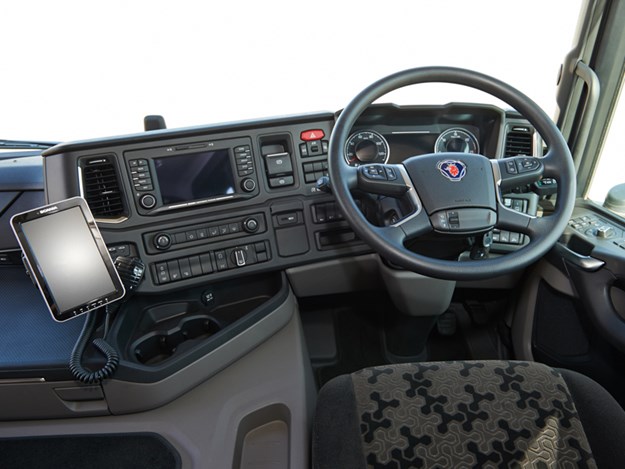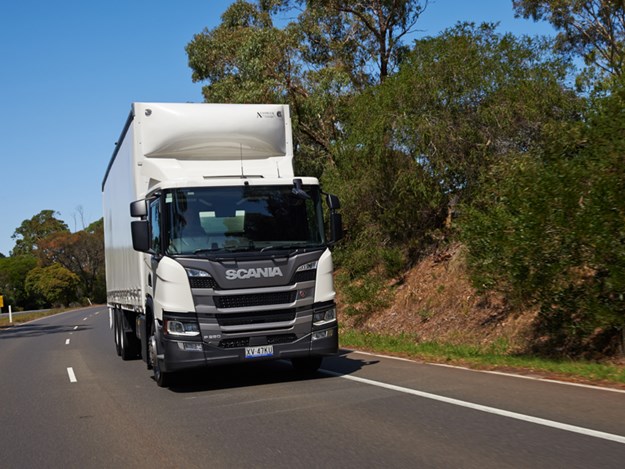In this three-part series Steve Brooks delves into all things Scania starting with a test drive from Sydney to Melbourne in a new R540 B-double before a one-on-one talk with Scania Australia’s quietly composed managing director Mikael Jansson on some of the factors behind the brand’s steady rise in recent years. Then back in Sydney, Brooks climbs into the new baby of the bunch, the 7.0 litre P-series.
In a shorthaul rigid truck market so thoroughly and fiercely dominated by Japanese models, it can be curious why local European brands bother to throw a slick and highly advanced contender into the mix when the likelihood of significant sales is perhaps as slim as the potential profit margin.
Then again, why not? Any new model does, of course, add another string to the business bow, and moreover, a high-tech ‘round-town toiler may even prove to be just the thing for some applications and individuals who might require significantly more than a relatively standard, off-the-shelf workhorse.
Scania, it seems, is figuring on just such a scenario for its new and extremely well equipped 7.0 litre P-series truck, because there’s no doubt that when it comes to top-shelf componentry in shorthaul and regional distribution roles, nothing comes close to the brand’s new baby.
The specification of a P280 6×2 demonstrator doing the promotional rounds recently was an excellent example of just how far Scania has gone in an obvious quest to needle its way into applications ruled by Japanese makers.
It all starts with the new 7.0 litre – actually, 6.7 litres – engine which is, in fact, the culmination of another development project between Sweden’s Scania and North American engine giant Cummins. These two powerhouses are long-term partners who have worked closely on a number of major engine and component exercises over many years – not least the well-proven XPI high pressure fuel injection system – so it’s no coincidence that the smallest engine Scania has offered in decades shares exactly the same displacement and dimensions as its Cummins equivalent, the 6.7 litre ISB engine.
Read our interview with Scania Australia chief Mikael Jansson, here
Yet Scania refutes any suggestion that its engine is simply a Cummins clone. All monitoring and control systems have, for instance, been developed by Scania, along with a fixed geometry turbocharger and an SCR emissions system for Euro 6 compliance. Accordingly, Scania says there are around 100 different parts in its version of the six cylinder 6.7 litre displacement which comes in 220, 250 and 280hp variants, with peak torque of 1200 Nm (885 lb ft) in the highest power rating.
As Scania is equally quick to point out though, the introduction of the engine known as the DC07 definitely does not mean the end of its current and more powerful five cylinder 9.0 litre engine which comes in Euro 5 and Euro 6 variants up to 360hp.
“We will continue to offer our 9.0 litre in the P-series which is ideally suited to heavier twin-steer and 6×4 applications,” says Scania Australia director of truck sales, Dean Dal Santo.
 |
|
All in the family. Scania’s P280 shares the same high standard of build quality and operational features as its bigger brothers. There’s a lot to like for shorthaul and regional work
|
However, what the addition of the 7.0 litre engine does mean is that it is able to contest much the same two, three and four axle rigid configurations as its 9.0 litre brother but with a significant weight saving up to 360kg and a 95mm lower engine hump between the seats in the P-series cab. Additionally, Scania says the lower floor ‘… allows the fitment of the same storage compartments as in (bigger) G-series cabs, plus there are new options for layouts with rear storage and bunks.’
With the 7.0 litre only available under the P-series cab and with a gross combination limit of just 30 tonnes – meaning the engine’s potential for prime mover duties is purposefully negligible – Scania’s target market for this addition to its New Truck Generation (NTG) is obviously shorthaul and regional work in rigid configurations. The way Scania sees it, the smaller, lighter engine will enhance the brand’s appeal in those delivery applications where a rigid truck might start the day at a gross weight around 20 tonnes but soon be down to 12 tonnes or so as deliveries are made.
Predictably, the engine is matched to a suitably tailored, direct-drive version of Scania’s sweet-shiftin’ Opticruise 12-speed automated transmission which, like its heavier-duty brethren, comes with two additional crawler gear ratios for slow manoeuvring as well as ‘economy’, ‘standard’ and ‘power’ operating modes.
With the box driving into a relatively quick 3.08:1 rear axle ratio, it’s a driveline which can comfortably cruise along a freeway – with 100 km/h reached at a twitch under 1550rpm – or calmly creep through metro mayhem.
Indeed, when it comes to piloting a six-wheeler rigid through choked city and suburban traffic tempos, it doesn’t come much smoother or easier than Scania’s lightweight specialist.
Ridin’ on Air
The demo truck’s 6×2 configuration came as no surprise. The single-drive three-axle configuration has been something of a Scania specialty for decades and it’s no exaggeration to suggest the Swedish maker has been arguably the biggest promoter of the 6×2 (and now 8×2) layout in both rigid and prime mover roles since the brand’s earliest days in Australia.
Sure, some early mechanically sprung versions didn’t quite light the fires of excitement when a truck became stranded on a gutter or the like, but the arrival of electronically controlled airbag suspensions which allowed axle height to be raised and lowered has done much to nullify the initial negatives.
Nowadays, airbag suspensions are the norm and in the P280, Scania has taken the evolution to its full extent with airbags on the steer axle as well as driven and non-driven rear axles. Typically, ride quality on everything from chopped secondary roads to slick highways was second to none.
Yet it’s worth mentioning that while earlier airbag designs on steer axles didn’t always deliver inspiring handling, the road manners and steering of the P280 were exceptionally sound in all conditions, with none of the wallowing or dipping in corners which limited the acceptance of some previous airbag steer axles.
Furthermore, the all-air Scania layout provides an individual axle weighing system which displays on a digital readout in the cab.
In the case of the demo truck, it was simply a case of scrolling the dash screen to the readout showing axle weights and instantly seeing that the front axle was loaded to 5.6 tonnes, the drive axle to 6.3 tonnes and the tag axle to 7.3 tonnes, for an all-up gross weight of 19.2 tonnes for the day-long test drive. What’s more, it also revealed a load weight of 7.7 tonnes which meant that tare weight of the 6×2 with a sturdy Austruck curtain-sided body and full fuel (320 litre) and AdBlue (47 litre) tanks was 11.5 tonnes.
Nor was it surprising that the smallest Scania offers a long list of highly advanced standard safety systems. As the company states, ‘Like all Scania trucks sold in Australia, the 7.0-litre specification includes a steering wheel-mounted driver SRS airbag and dual side rollover curtain airbags as standard, along with advanced emergency braking, electronic traction control and lane departure warning systems. Brakes are by discs all round’.
LED lights all-round, including daytime running lights, are a similarly standard feature as is the hugely beneficial auto ‘Hill Hold’ feature.
On the inside, and typifying the high level of build quality in Scania’s NTG range, the day cab demonstrator was a superb workplace for shorthaul and regional duties; immensely comfortable and well-appointed with even a small fridge between the seats, and all controls and switchgear in easy reach and equally, easily understood.
Likewise, it took little time behind the wheel to be fully at ease with the Scania’s road manners and appreciate the truck’s attributes in smoothly coping with the suburban slog. In other areas though, the smallest Scania wasn’t quite as convincing.
 |
|
Around town, the P280 was a delight and throttle response from the 7.0 litre engine is impressive. Out on the open road though, undulating conditions highlight the modest displacement’s shortage of gritty determination
|
On a wickedly wet day and with almost 29,000km on the clock at the start of our run from Scania’s Prestons dealership in Sydney’s south-western suburbs, the P280 was run along the Hume before turning east and dropping down Mt Ousley for a short jaunt around Wollongong’s industrial backblocks. Then, headed up Ousley for a run into Sydney’s southern suburbs and a meander through peak hour metro madness on the way back to Scania’s dealership. All up, a 200km mix which probably typified the model’s likely workloads.
Around town, the P280 is perfectly at ease. Smooth, quiet, agile and with enough response from the 7.0 litre engine to comfortably keep pace with erratic traffic flows.
On undulating open roads though, the small displacement engine’s lively throttle response is not matched by an inherent propensity for pulling power.
Admittedly, peak performance figures of 280hp (206kW) at 1900rpm and 1200Nm (885lb-ft) of torque on tap from 1050 to 1600rpm suggest a wide and reasonably tenacious fight but as numerous climbs showed with the transmission in auto mode, the powertrain rarely utilises the full extent of the torque band. Instead, it was quick to drop a gear at 1400 or 1500rpm rather than dig deeper and utilise more of the available torque output.
On more demanding climbs, manual mode at least allowed the full torque band to be utilised before making a single downshift or on sharper pinches, taking two gears to use more of the rev range.
When it’s all boiled down, Scania’s 7.0 litre is simply a small displacement engine with a typically high level of throttle response but an equally typical lack of gritty pulling power.
Likewise, exhaust brake performance wasn’t particularly inspiring. According to Scania’s figures, maximum exhaust braking effect is a modest 88kW at 2500rpm which is again indicative of a small bore engine.
Overall though, there’s a great deal to like about Scania’s P280 6×2, not least fuel economy. At the end of a demanding day, the truck returned an entirely acceptable 3.2km/litre, or 9.1mpg.
Just as Scania says, its new 7.0 litre rigid model is ideally suited to shorthaul delivery work or regional runs. However, if the regional runs have plenty of hills, it’d probably be worth stepping up to the 9.0 litre engine.
Sometimes, you just can’t beat cubes.

